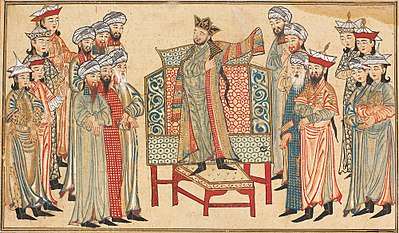Robe of honour
A robe of honour (Arabic: khilʿa, plural khilaʿ, or tashrīf, pl. tashārif or tashrīfāt[1]) was a term designating rich garments given by medieval and early modern Islamic rulers to subjects as tokens of honour, often as part of a ceremony of appointment to a public post, or as a token of confirmation or acceptance of vassalage of a subordinate ruler. They were usually produced in government factories and decorated with the inscribed bands known as ṭirāz.

History
The bestowment of garments as a mark of favour is an ancient Middle Eastern tradition, recorded in sources such as the Old Testament and Herodotus.[1]
In the Islamic world, Muhammad himself set a precedent when he removed his cloak (burda) and gave it to Ka'b bin Zuhayr in recognition of a poem praising him. Indeed, the term khilʿa "denotes the action of removing one's garment in order to give it to someone".[1]
The practice of awarding robes of honour appears in the Abbasid Caliphate, where it became such a regular feature of government that ceremonies of bestowal occurred almost every day, and the members of the caliph's court became known as "those who wear the khilʿa" (aṣḥāb al-khilʿa).[1] The bestowal of garments became a fixed part of any investment into office, from that of a governor to the heir-apparent to the throne. As important court occasions, these events were often commemorated by poets and recorded by historians.[1]
In Fatimid Egypt, the practice spread to the wealthy upper middle classes, who began conferring robes of honour on friends and relatives, in emulation of the aristocracy.[1] Under the Mamluk Sultanate of Egypt, the system was standardized into a system of classes reflecting the divisions of Mamluk society, each with its own ranks: the military (arbāb al-suyūf), the civilian bureaucracy (arbāb al-aqlām), and the religious scholars ( al-ʿulamāʾ).[1] The distribution of the robes of honour was the responsibility of the Keeper of the Privy Purse (Nāẓir al-Khāṣṣ), who supervised the Great Treasury (al-khizāna al-kubra), where the garments were stored.[1] Maqrizi provides a detailed description of the garments worn by the various classes and ranks; in addition, Mamluk practice included the bestowal of arms, or even a fully outfitted horse from the Sultan's own stables, as a tashrīf.[1] The practice remained very common until the early 20th century; in 19th-century India, the bestowal gift or khillaut (khelat, khilut, or killut) might comprise from five up to 101 articles of clothing.[2]
As the practice spread in the Islamic world, and robes began to be given for every conceivable occasion, they also acquired distinct names. Thus for example the khilaʿ al-wizāra ("robe of the vizierate") would be given on the appointment to the vizierate, while the khilaʿ al-ʿazl ("robe of dismissal") upon an—honourable—dismissal, the khilaʿ al-kudūm might be given to an arriving guest, while the khilaʿ al-safar would to a departing guest, etc.[2]
Sums of money or other valuables were also given as part of the bestowal ceremony, or, in some cases, in lieu of the robe. In the Ottoman Empire, such a sum was known as khilʿet behā ("price of khilʿa"); most commonly this referred to the donative received by the Janissaries on the accession of a new sultan.[3]
References
- Stillmann 1986, p. 6.
- Stillmann 1986, p. 7.
- Stillmann 1986, pp. 6–7.
Sources
- Mayer, Leo Ary (1952). Mamluk Costume: A Survey. A. Kundig.CS1 maint: ref=harv (link)
- Stillmann, N. A. (1986). "K̲h̲ilʿa". In Bosworth, C. E.; van Donzel, E.; Lewis, B. & Pellat, Ch. (eds.). The Encyclopaedia of Islam, New Edition, Volume V: Khe–Mahi. Leiden: E. J. Brill. pp. 6–7. ISBN 90-04-07819-3.